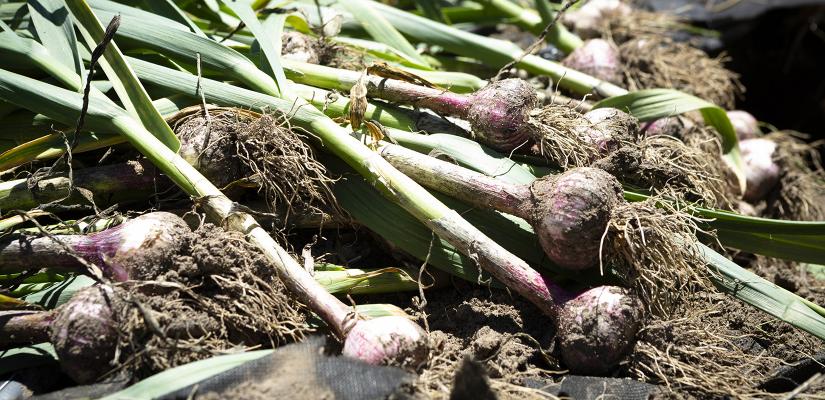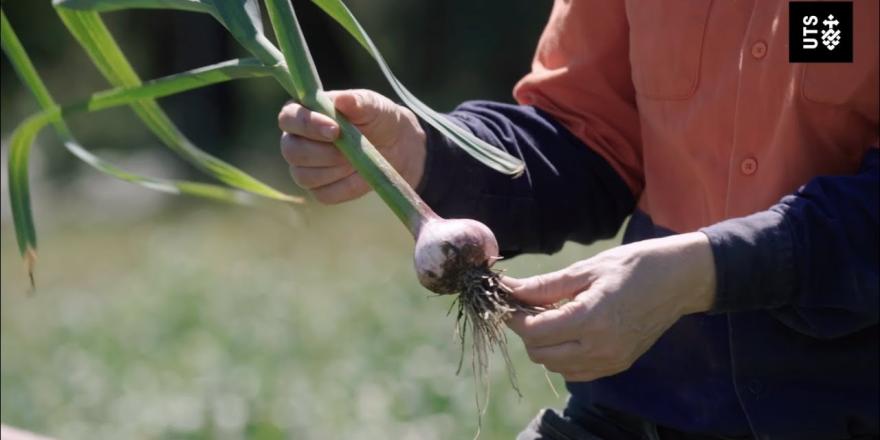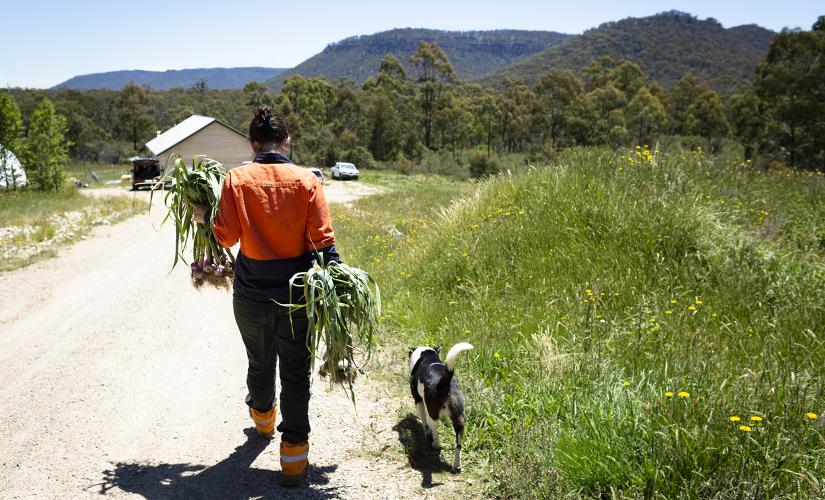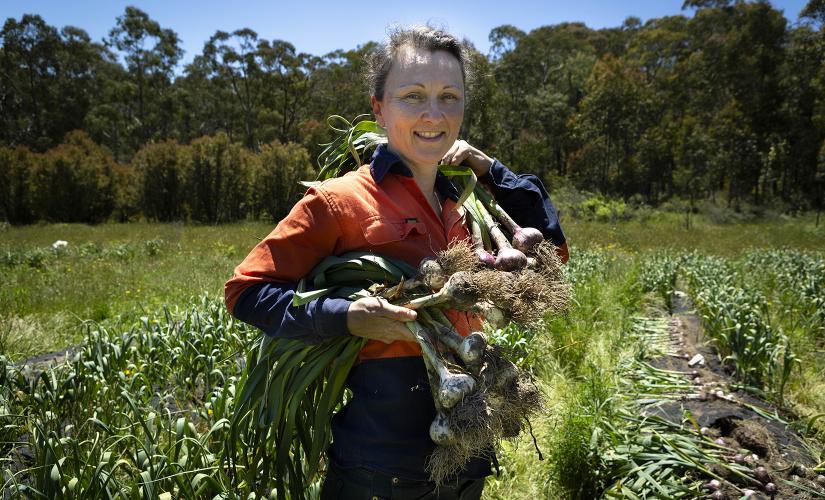An innovative project at UTS is turning organic waste into a valuable resource. Food scraps collected on campus are composted to grow garlic that flavours food right across Sydney. The recipe for success is collaboration, with critical ingredients from UTS research, education, operations and communications.

Garlic grown by the Hartley Vale Good Garlic Co.
A university-wide project at UTS is showing how innovation and collaboration can transform food ‘waste’ into a valuable resource.
Scraps collected from kitchen bins and cafes across campus are processed on-site in two large dehydrators. The resulting nutrient-rich soil conditioner is transported to a farm in Hartley Vale (near Lithgow), where it’s composted and used to grow organic garlic. Once harvested, part of the crop is brought back to UTS, where it’s distributed to garlic-loving students and staff through the UTS Food Co-operative. And the cycle starts again.
The project is led by Associate Professor Dena Fam, a researcher with the UTS Institute for Sustainable Futures (ISF). It’s involved scores of design students, researchers and operations staff, as well as government and industry partners, who have worked closely to create this model for sustainability.
And it’s recently won an Australasian Green Gown Award, for Outstanding Leadership by a Team.

[Upbeat electronic music]
Michelle Zeibots:
The Hartley Vale Good Garlic Company is located at a farm called The Refinery near Lithgow.
At my farm, we produce organically grown garlic using compost that’s been made from coffee grounds and food waste from UTS.
The circular economy is a process that uses waste from one part of the system and then uses that waste to produce something new at another point in the system.
And that’s what we do with the compost that we use to fertilise our soils that helps us to grow delicious and very healthy food.
Dena Fam:
The collaboration really crosses teaching and learning, and research, but also operations, communications.
We had really good engagement with the communications teams at UTS that were actually involved in developing comms based on the workshops and research we did on this project.
The living lab is really about getting students to intimately experience a system and have the opportunity to intervene somewhere or influence how that system changes to improve in the sense of having a really operational circular economy.
Ian McInnes:
Our cleaners are instrumental in collecting the food waste around UTS.
They sort through the food waste to remove any impurities and prepare it for the food dehydrator.
After 24 hours the food waste is removed from the machine and is now classed as soil conditioner and is taken to be used at the garlic farm.
Dena Fam:
We really need to be able to work collaboratively to be able to operationalise a circular economy in practice.
And what UTS is trying to do is complete the cycle, from the production of food waste, the processing of food waste, right through to the use of food waste as a resource in farming.
And UTS is a pilot for something much bigger.
We have an opportunity to do that at a much bigger scale. A city scale. A precinct scale.
Reduce, assess, refine
The motivation driving the project is the search for an efficient and useful way to divert food waste from landfill, while reducing greenhouse gas emissions.
“When we started processing food waste at UTS, the dehydrated soil conditioner was sent to a commercial processing plant outside Sydney for additional processing, to turn it into pelletised fertiliser, which was then sent to Perth, Wagga and Victoria,” explains Dena.
“The greenhouse gas emissions generated by shipping fertiliser so far away are significant. If you can reduce the distance between where waste is produced, processed and where it’s ultimately re-used, you have the potential to radically reduce emissions,” says Dena.
The dehydrated soil conditioner now gets transported direct from UTS to the farm in Hartley Vale, which is owned by fellow ISF researcher Dr Michelle Zeibots. That’s where Michelle operates the Hartley Vale Good Garlic Co., where the last tasty part of the partnership takes place.
“Because we’re using the soil conditioner for our compost, we’re not using artificial fertilisers, which have another greenhouse gas emission cost. And we’re getting a better and healthier crop,” says Michelle.
“That’s key to the circular economy. You’re replacing energy-intensive processes that would have wasted energy and resources with new, improved processes that simply create better products and environmental outcomes.”
Changing behaviours
Throughout the project, the UTS campus became a transdisciplinary ‘living lab’, where design students engaged with cleaners and operations staff to implement this approach to waste management, developing critical skills to take into their careers.
“The Transdisciplinary Living Labs (TDLL) give students the opportunity to intimately engage with the food waste system at UTS while also reflecting on their own food waste management practices at home and on campus. They met with experts in food waste management systems, including with organisations such as the NSW Environment Protection Authority (EPA), local councils and technology providers, giving them the opportunity to really experience the challenges of shifting the current system toward a circular economy,” says Dena.
“They got hands-on experience designing a raft of communications elements including signage, DIY bin-liner instructions and an app, that engaged with the whole UTS community and contributed to improving UTS waste management systems.”
To be successful, the project needed to engage the UTS community and create new habits and practices that value waste as a resource. UTS operations and communications staff worked in tandem with the student labs to develop campaigns across multiple mediums.

No audio
From soil conditioner to compost
To produce the soil conditioner, UTS operations collect food waste from cafes and kitchens, checking for contaminants before processing in rapid food waste dehydrators, which reduce the volume by 70-90%.
When it arrives at Michelle’s farm, the soil conditioner goes through a minimum six-month composting process.
“It gets mixed with dry leaves and coffee grounds before being formed into windrows, where it reaches high temperatures just from the decomposition process. When I stick my hand in the mounds it’s very hot to touch and almost burns,” says Michelle.
“That heat kills off all the nasty stuff including weed seeds. As it decomposes, you get enormous numbers of earthworms that are naturally attracted to it. You have to put it through the compost process to make the nutrients available to plants.”
Having access to a wide, open space for this naturally occurring process is essential.
“You can’t use the soil conditioner straight out of the dehydrator. If you want to use it in agricultural production, the dehydrated food waste needs to be composted for six months,” Dena explains. “The composting on site at Hartley Vale to meet NSW EPA regulations is such a bonus for UTS.”

Dr Michelle Zeibots at her farm in Hartley Vale, home to the Hartley Vale Good Garlic Co.
Refining the flavour
Hartley Vale is a small village just west of the Blue Mountains on the outskirts of Sydney, with a population of around 27.
Michelle’s farm is called ‘The Refinery’, a nod to the history of the local area, which was home to the Hartley Vale oil shale refinery.
Applying many ideas and sustainability principles generated by ISF researchers, Michelle is bringing the farm into the future.
“The off-grid electricity system, waterless toilets and hempcrete farm building where the garlic is dried and cured before going to market, are all part of a sustainability vision. I’m finding the ISF philosophy very easy to apply in practice,” says Michelle.
All of these sustainability inputs are helping Michelle refine her farming practices – with tasty results. For three years now, she’s harvested a range of very healthy garlic varieties without the need for pesticides or synthetic fertilisers. She’s currently harvesting their third season — which has been a bumper crop.
“A lot of people don’t know that garlic is like wine, cheese or potatoes. There are many different kinds. Like wine, each variety has a different ‘palate’, and you select the kind of garlic to use that best suites the dish you’re making,” says Michelle.

Dr Michelle Zeibots with organic garlic grown on her farm in Hartley Vale.
Growing the results
While the results of the UTS collaboration are already impressive, there’s plenty of room to grow.
The model has drawn interest from other organisations including the City of Sydney, Leura Village Association and Blue Mountains City Council, South Sydney Regional Organisation of Councils and TAFE NSW. Staff from the University of Sydney, Newcastle and Macquarie universities, have also visited UTS to gain insight into UTS food waste management practices as part of a knowledge sharing process.
“Four million tonnes of food waste is being created each year in Sydney. That’s a lot of valuable nutrients being wasted,” exclaims Michelle. “Imagine what could be achieved in our farming communities located around Sydney if that food waste could be turned into compost for horticulture and food production.”
There’s also room to grow involvement from the broader community.
“The UTS model gives everyone a worthwhile reason for doing the right thing and learning how to properly sort food waste for reuse. Keeping plastic out of the organic food waste stream keeps plastic out of the soils on my farm and ultimately everyone’s food chain,” explains Michelle.
“By separating our organic waste and reducing contamination from plastic, we can all enjoy more healthy, tasty and locally-grown organic foods.”

